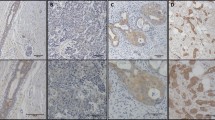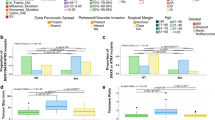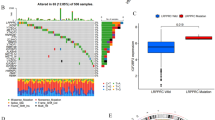Abstract
Cancer-associated DNA hypomethylation is as prevalent as cancer-linked hypermethylation, but the biological significance of DNA hypomethylation in carcinogenesis is less understood. The expression of Maspin (mammary serpin) in differentiated normal cells is regulated by epigenetic modifications in a cell-type-specific manner. Paradoxical Maspin expression due to epigenetic modification has been addressed in several cancer cell types. To elucidate the role of the Maspin gene in thyroid cancer, we studied methylation status in the promoter region and its expression in six human undifferentiated thyroid cancer cell lines and in specimens from 92 primary thyroid tumors, consisting of six follicular adenomas, 56 well-differentiated thyroid cancers (WDTCs), 17 poorly differentiated thyroid cancers (PDTCs) and 13 undifferentiated thyroid cancers (UDTCs). Three of the six cell lines overexpressed Maspin mRNA and its protein product, but the remaining three did not. The methylation status at the promoter region was inversely correlated with Maspin expression. In Maspin-negative cell lines, Maspin expression was induced by treatment with 5-aza-2′-deoxycytidine, a DNA demethylating agent. Immunoreactivity for Maspin protein was frequently detected in UDTCs (8/13, 62%) and PDTCs (7/17, 41%). Immunoreactivity for Maspin was diffusely positive in UDTCs, and was restricted to dedifferentiated components of the tumor in PDTCs. Positive immunoreactivity was infrequent in WDTCs (1/56, 2%), and all follicular adenomas and normal thyroid glands were completely negative. Their methylation status evaluated by the methylation-specific PCR method showed a good inverse correlation with their immunoreactivity in surgically resected specimens. Our data suggest that overexpression of Maspin by DNA hypomethylation is closely associated with morphological dedifferentiation in thyroid cancers.
This is a preview of subscription content, access via your institution
Access options
Subscribe to this journal
Receive 50 print issues and online access
$259.00 per year
only $5.18 per issue
Buy this article
- Purchase on Springer Link
- Instant access to full article PDF
Prices may be subject to local taxes which are calculated during checkout






Similar content being viewed by others
Abbreviations
- UDTCs:
-
undifferentiated thyroid cancers
- RQ-PCR:
-
real-time quantitative PCR
- 5-aza-dC:
-
5-aza-2′-deoxycytidine
- SNP:
-
single nucleotide polymorphism
- WDTCs:
-
well differentiated thyroid cancers
- PDTCs:
-
poorly differentiated thyroid cancers
- MSP:
-
methylation-specific PCR
References
Abraham S, Zhang W, Greenberg N and Zhang M . (2003). J. Urol., 169, 1157–1161.
Akiyama Y, Maesawa C, Ogasawara S, Terashima M and Masuda T . (2003). Am. J. Pathol., 163, 1911–1919.
Berlingieri MT, Musti AM, Avvedimento VE, Di Lauro R, Di Fiore PP and Fusco A . (1989). Exp. Cell. Res., 183, 277–283.
Clark SJ, Harrison J, Paul CL and Frommer M . (1994). Nucleic Acids Res., 22, 2990–2997.
del Senno L, Gambari R, degli Uberti E, Barbieri R, Bernardi F, Buzzoni D, Marchetti G, Pansini G, Perrotta C and Conconi F . (1987). Cancer Detect. Prevent., 10, 159–166.
Domann FE, Rice JC, Hendrix MJ and Futscher BW . (2000). Int. J. Cancer, 85, 805–810.
Eden A, Gaudet F, Waghmare A and Jaenisch R . (2003). Science, 300, 455.
Ehrlich M . (2002). Oncogene, 21, 5400–5413.
Ehrlich M, Jiang G, Fiala E, Dome JS, Yu MC, Long TI, Youn B, Sohn OS, Widschwendter M, Tomlinson GE, Chintagumpala M, Champagne M, Parham D, Liang G, Malik K and Laird PW . (2002). Oncogene, 21, 6694–6702.
Elisei R, Shiohara M, Koeffler HP and Fagin JA . (1998). Cancer, 83, 2185–2193.
Feinberg AP and Vogelstein B . (1983). Nature, 301, 89–92.
Frisk T, Foukakis T, Dwight T, Lundberg J, Hoog A, Wallin G, Eng C, Zedenius J and Larsson C . (2002). Genes Chromosomes Cancer, 35, 74–80.
Futscher BW, Oshiro MM, Wozniak RJ, Holtan N, Hanigan CL, Duan H and Domann FE . (2002). Nat. Genet., 31, 175–179.
Gama-Sosa MA, Slagel VA, Trewyn RW, Oxenhandler R, Kuo KC, Gehrke CW and Ehrlich M . (1983). Nucleic Acids Res., 11, 6883–6894.
Gaudet F, Hodgson JG, Eden A, Jackson-Grusby L, Dausman J, Gray JW, Leonhardt H and Jaenisch R . (2003). Science, 300, 489–492.
Graff JR, Greenberg VE, Herman JG, Westra WH, Boghaert ER, Ain KB, Saji M, Zeiger MA, Zimmer SG and Baylin SB . (1998). Cancer Res., 58, 2063–2066.
Hedinger C, Williams ED and Sobin LH . (1998). Histologic Typing of Thyroid Tumours, 2nd edn. Springer Verlag: Berlin.
Ishiwata I, Sudo T, Kiguchi K and Ishikawa H . (1999). Hum. Cell, 12, 37–46.
Ito T, Seyama T, Mizuno T, Tsuyama N, Hayashi T, Hayashi Y, Dohi K, Nakamura N and Akiyama M . (1992). Cancer Res., 52, 1369–1371.
Jiang N, Meng Y, Zhang S, Mensah-Osman E and Sheng S . (2002). Oncogene, 21, 4089–4098.
Maass N, Hojo T, Ueding M, Luttges J, Kloppel G, Jonat W and Nagasaki K . (2001). Clin. Cancer Res., 7, 812–817.
Matsuo K, Tang SH, Zeki K, Gutman RA and Fagin JA . (1993). J. Clin. Endocrinol. Metab., 77, 991–995.
Rosai J, Carcangiu ML and Delellis RA . (1994). Tumors of the Thyroid Gland, Third edn. Armed Forces Institute of Pathology: Washington, DC.
Schagdarsurengin U, Gimm O, Hoang-Vu C, Dralle H, Pfeifer GP and Dammann R . (2002). Cancer Res., 62, 3698–3701.
Seftor RE, Seftor EA, Sheng S, Pemberton PA, Sager R and Hendrix MJ . (1998). Cancer Res., 58, 5681–5685.
Sheng S, Carey J, Seftor EA, Dias L, Hendrix MJ and Sager R . (1996). Proc. Natl. Acad. Sci. USA, 93, 11669–11674.
Sood AK, Fletcher MS, Gruman LM, Coffin JE, Jabbari S, Khalkhali-Ellis Z, Arbour N, Seftor EA and Hendrix MJ . (2002). Clin. Cancer Res., 8, 2924–2932.
Venkataraman GM, Yatin M, Marcinek R and Ain KB . (1999). J. Clin. Endocrinol Metab., 84, 2449–2457.
Wreesmann VB, Ghossein RA, Patel SG, Harris CP, Schnaser EA, Shaha AR, Tuttle RM, Shah JP, Rao PH and Singh B . (2002). Am. J. Pathol., 161, 1549–1556.
Xia W, Lau YK, Hu MC, Li L, Johnston DA, Sheng S, El-Naggar A and Hung MC . (2000). Oncogene, 19, 2398–2403.
Yoshida M, Matsuzaki H, Sakata K, Takeya M, Kato K, Mizushima S, Kawakita M and Takatsuki K . (1992). Cancer Res., 52, 464–469.
Yoshimoto K, Iwahana H, Fukuda A, Sano T, Saito S and Itakura M . (1992). Cancer Res., 52, 5061–5064.
Zhang M, Maass N, Magit D and Sager R . (1997). Cell Growth Differ., 8, 179–186.
Zou Z, Anisowicz A, Hendrix MJ, Thor A, Neveu M, Sheng S, Rafidi K, Seftor E and Sager R . (1994). Science, 263, 526–529.
Acknowledgements
We thank Drs Hideo Sugawa and Isamu Ishiwata for providing cell lines (HTC/C3 and HOTHC, respectively). We are also grateful to Ms Naoko Sasaki, Ms Sachiko Fujiwara and Mr Akihiko Ushirokawa for technical assistance.
Author information
Authors and Affiliations
Corresponding author
Additional information
Supported by Grant-in-Aid for Scientific Research 14571222, 14571221 and 15790698 from the Japanese Ministry of Education, Science, Sports and Culture
Rights and permissions
About this article
Cite this article
Ogasawara, S., Maesawa, C., Yamamoto, M. et al. Disruption of cell-type-specific methylation at the Maspin gene promoter is frequently involved in undifferentiated thyroid cancers. Oncogene 23, 1117–1124 (2004). https://doi.org/10.1038/sj.onc.1207211
Received:
Revised:
Accepted:
Published:
Issue Date:
DOI: https://doi.org/10.1038/sj.onc.1207211
Keywords
This article is cited by
-
Altered Epigenetic Mechanisms in Thyroid Cancer Subtypes
Molecular Diagnosis & Therapy (2018)
-
Maspin: molecular mechanisms and therapeutic implications
Cancer and Metastasis Reviews (2012)
-
DNA methylation profiles of protease nexin 1 (SERPINE2) gene in human cell lines
Chinese Journal of Cancer Research (2011)
-
DNA methylation or histone modification status in metastasis and angiogenesis-related genes: a new hypothesis on usage of DNMT inhibitors and S-adenosylmethionine for genome stability
Cancer and Metastasis Reviews (2010)
-
DNA hypomethylation in the origin and pathogenesis of human diseases
Cellular and Molecular Life Sciences (2009)



